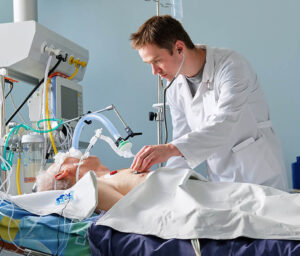Understanding Hospital-Acquired Infections
Having a patient diagnosed with a hospital-acquired infection after being admitted to the hospital or soon after discharge is more common than you may think. According to the CDC, about 1 in 31 hospital patients contract a hospital-acquired infection on any given day.
Hospital-acquired infections, also known as healthcare-associated infections (HAIs), are infections that patients get while receiving medical care at a healthcare facility. These infections can develop when bacteria enters the body in some way, including through a wound, a device, or unclean surfaces or hands.
While there are several hospital-acquired infections, in today’s post we’ll be reviewing some of the most common hospital-acquired infections, which patients are most at risk of contracting them, and how hospitals can prevent them.
The Most Common Types of Hospital-Acquired Infections
Catheter-Associated Urinary Tract Infections (CAUTIs)
Catheter-associated urinary tract infections are the most widely reported HAI, accounting for nearly 40% of all HAIs. CAUTIs can occur when bacteria enters the urinary tract. This can happen during catheter insertion, if the patient’s drainage bag isn’t emptied regularly, or if urine flows back into the bladder.
CAUTIs are usually associated with the prolonged use of urinary catheters. One of the easier ways to prevent CAUTIs is to only use a urinary catheter when necessary and to make sure it is removed promptly.
Surgical Site Infections
Surgical site infections are the second most common HAI, accounting for 22% of all HAIs among hospital patients. Surgical site infections (SSIs) are infections that occur after surgery, in the area of the body where the procedure took place. SSIs can be caused by improper skin preparation, improper sterile technique, surgical duration, or even the amount of traffic in the operating room.
The most common surgical site infections include Staphylococcus, Streptococcus, and Pseudomonas. Most SSIs are treatable with antibiotics, however, some patients will need another surgery to treat the infection.
 Ventilator-Associated Pneumonia & Hospital-Acquired Pneumonia
Ventilator-Associated Pneumonia & Hospital-Acquired Pneumonia
Ventilator-Associated Pneumonia (VAP) is a type of hospital-acquired pneumonia that develops more than 48 hours after a patient has been intubated and put on a ventilator. Patients are at the highest risk for developing VAP during the first 10 days after intubation, with VAP occurring in approximately 9 – 27% of ventilated patients.
Hospital-acquired pneumonia is common among patients who have a compromised immune system or the elderly. Symptoms can vary from high fever, increased white blood cell count, and worsening oxygenation.
Central-Line Associated Bloodstream Infections (CLABSIs)
Central-line associated bloodstream infections are serious infections that develop within 48 hours of a central line being placed. Central lines are placed to access a major vein close to the heart to give patients medication, fluids, or to collect blood. Central lines often remain in place for weeks or months, making them much more likely to cause infection.
CLABSIs are extremely costly for hospitals with each infection costing approximately $46,000 per case. To prevent CLABSI, healthcare professionals need to follow strict protocols to make sure the central line remains sterile.
Which Patients are Most at Risk?
All patients are susceptible to developing a hospital-acquired infection, especially if proper procedure isn’t followed. However, some patients are more susceptible to HAIs than others. These patients include:
- Elderly patients
- Infants
- Immunocompromised patients
- Patients using invasive medical devices such as foley catheters or breathing tubes
- Patients who have long hospital stays
Preventing Hospital-Acquired Infections
Hospital-acquired infections are preventable, and most, if not all, hospitals have policies in place to keep HAIs to a minimum. However, these infections can still slip through the cracks.
One of the easiest ways to help reduce hospital-acquired infections is to improve infection control strategies. A few strategies include:
- Proper handwashing
- Disinfecting and keeping high-touch surfaces clean
- Proper PPE
- Refer to a device’s instructions for use
- Avoid using expired supplies
- Use single-use medical devices
Surgilube® Surgical Lubricant is the #1 surgical lubricant for medical professionals. Formulated with chlorhexidine to support infection control, Surgilube® products are available in single-use packets and are sterile and bacteriostatic. If your facility is looking to reduce hospital-acquired infections, request a sample of Surgilube® today.
